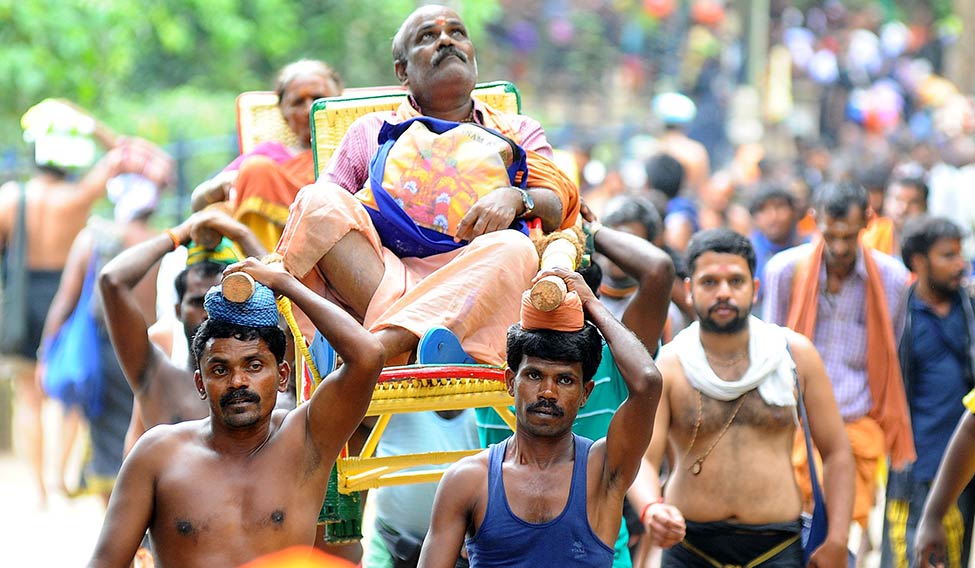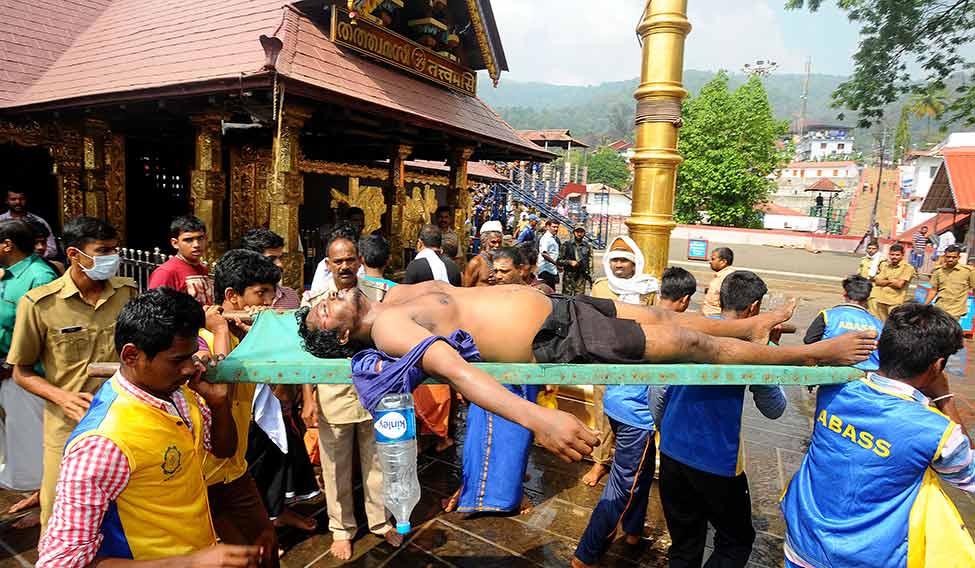The Sabarimala Sree Dharma Sastha temple, situated amidst 18 hills at the Periyar Tiger Reserve at 3,000 feet above sea level in Kerala, attracts four crore people during the pilgrimage season from mid-November to mid-January. After crossing the Pamba river, they trek more than five kilometres through the forest to worship at Sannidhanam, the seat of the Dharma Sastha, who is better known as Ayyappan.
It is a steep climb, an arduous one for the generally sedentary people, and it makes the heart race. For some, it turns fatal. In the past few years, the number of cardiac-related deaths during the climb has averaged around 50. Last season, the deaths of 54 pilgrims were attributed to the strenuous trek, and in the current season there have been 38 such deaths.
Sannidhanam has four hospitals—the government general hospital, an Ayurveda hospital, SAHAS Cardiology Centre, and NSS Hospital—all of which give free treatment. Pamba has a government hospital and an Ayurvedic hospital, as well as the Amrita Healthcare Centre, which also offer free treatment. On the five-km route from Pamba to Sannidhanam, there are 18 emergency medical centres (EMCs) equipped with oxygen parlours and portable ventilators. The government hospital at Pamba, which serves as the base camp for the health department’s centres in and around Sabarimala, has eight doctors on duty, including two cardiologists and a surgeon, a five-bed intensive care unit and advanced life-support ambulances.
Dr Suresh Babu, Kerala health department’s nodal officer for Sabarimala, said that about 1,14,000 pilgrims had sought treatment at the government hospitals in and around Sabarimala this season. “Out of these, 105 [cases] were heart attacks and 15,554 were heart-related. So, about 15 per cent of total patients had heart-related ailments or were prone to cardiac arrests. They are the major risk group.” When the pilgrims in this risk group trek some of the more difficult stretches, their hearts overwork to meet the increased oxygen demand. “So rest is vital in this situation. But they are in a frenzy of devotion and continue climbing, ignoring wayside signs instructing people to rest.”
When a pilgrim collapses during the climb, volunteers of Akhila Bharata Ayyappa Seva Sangham rush to his rescue. The non-profit organisation has 416 volunteers at the temple this season, mostly students from colleges across the border in Tamil Nadu. Forty of them are in the stretcher service to carry those who are unwell to the EMCs or hospitals. They have saved 66 critical patients this season. In one remarkable case, a pilgrim who was on ventilator at the EMC at Apachimedu was carried down to Pamba using a portable ventilator. The patient, Satish Kumar, 46, a native of Tamil Nadu, was taken off ventilator at Kottayam Medical College a few days later.
Volunteers at the EMCs also rush to the location of distress calls with oxygen masks. Timely interventions from these two groups make a crucial difference in life-or-death situations. Other volunteers stand at various points between the 18 EMCs to spot those who may be at risk and advise them to slow down or rest, as well as supply hot, medicated drinking water.
Thanjavur Damodaran, an ABASS veteran who has been at Sabarimala for 34 years, is the captain of its emergency division here. He said medication for heart-related aliments had been found in the bags of many people who died on the route. “They knew they had heart problems and they knew the climb was difficult. When patients like them reach Pamba, they should show the doctors the medicines, get a check-up done and get their advice. Most people don’t do this. Doctors work here 24x7. Consult before climbing. If they tell you, ‘your blood pressure is high, so rest at Pamba and climb tomorrow morning’, listen to them.”
Some people are told not to climb at all, but take the “dolly” service. Men carrying pilgrims in dollies—easy chairs affixed on two long poles—is a common sight at Sabarimala. The service started in the mid-1960s when governor V.V. Giri, the future president, visited Sabarimala. The Travancore Devaswom Board, which administers the temple, transformed a chair into a dolly to take Giri to Sannidhanam as his doctors had advised him not to engage in strenuous activity. The board had trained six men to carry the dolly then. Today, there are more than 300 dollies and thousands of dolly bearers. They charge 04,000 for the service and pay the Devaswom Board a fee of Rs 200.
Sree Ayyappa Health Amenities Society, which runs the SAHAS Cardiology Centre at Sannidhanam, was formed in 1993 to provide specialised care, free of cost, to pilgrims. All its cardiac care equipment were donated by Tata Tea Ltd. Dr O. Vasudevan, chief medical officer and vice president of SAHAS Cardiology Centre, said some more precautionary measures were required. “I had suggested the newly built emergency path [near the queues close to the temple] to facilitate fast movement of volunteers carrying stretchers. But now people queue up in this path also. The police should ensure that this path is clear at all times.” He said the temple required a well-equipped trauma care centre. “The facilities for trauma care are not adequate. We [SAHAS] are trying to raise funds and find volunteer doctors to start a trauma care department. This is important not only during stampedes, but also to treat the many injuries people sustain while climbing.”
 Cash and carry: ‘Dolly’ bearers carry pilgrims up and down the hill for a charge of Rs 4,000 | Rajesh Babu N.
Cash and carry: ‘Dolly’ bearers carry pilgrims up and down the hill for a charge of Rs 4,000 | Rajesh Babu N.
On December 25, as many as 31 people were injured in a stampede near Malikappuram, a smaller temple at Sannidhanam. The government hospital at Sannidhanam could handle the emergency because many of the victims had only minor injuries. Dr Suresh Babu told THE WEEK that eight people were referred to the Kottayam Medical College, four of them with critical injuries. Though the hospital at Sannidhanam had the necessary personnel and medicines, it has limited space. “Space crunch is a feature of this kind of terrain. A new three-storey building is going to be constructed in place of the present Sannidhanam hospital before next season, and if we can build more wards in the building, there would be sufficient space to treat people injured in stampedes. But, we need to send strong messages to the devotees. Preparation for Sabarimala is not only about observing austerities; it is also about being patient. Devotees will have to stand in a queue for hours and if they show the slightest impatience it could lead to a stampede,” he said.
Witnesses said the stampede would have caused more damage but for the fast reaction of the National Disaster Response Force. The NDRF here has a team of 60 working round the clock. It is trained to deal with stampedes, provide critical medical care and carry out search and rescue operations. Assistant Commandant Jithesh T.M. of NDRF Battalion 4, Arakkonam, said 45 personnel had been deployed at 3pm on the day of the stampede. “The incident occurred at 6:45pm, and two of our teams were only about 30 to 40 metres away. We immediately charged in, created a barricade and shifted those who had fallen. The police rushed to cover us and the ABASS volunteers were also there in an instant. Together we were able to restore normalcy and evacuate the injured by responding to distress calls,” he said.
Personnel from the Rapid Action Force of CRPF 105 battalion are also at the temple. Deputy Commandant, Operations, M.G. Nair said that though their primary objective was to repulse any armed attack on the temple, the RAF also helped the police manage crowd if it got out of hand.
Kerala Police Superintendent S. Surendran, who is police special officer for Sabarimala, said about four crore people visited Sabarimala last season. The Devaswom Board expects at least a 20 per cent increase this season. As footfall increases, the devotees will also have to be more responsible and consider health and safety, both their own and that of others, an important part of their pilgrimage. For now, the commitment of the men serving at the holy hillock is making all the difference—from volunteers carrying the injured over steep slopes and NDRF personnel charging in to stampedes, to the earnest efforts of doctors, and the silent vigil of hundreds of police officers. These men, not divine intervention, make Sabarimala a safer place.
WITH T.K. RAJAPPAN








